
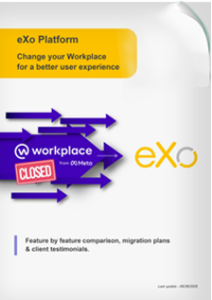

FREE WHITE PAPER
Discover, compare, and migrate to the best Workplace From Meta alternative
On August 31, 2025, Workplace from Meta will be permanently shut down. From this date until May 31, 2026, companies will have read-only access to their content and will still be able to download existing data. After this date, the service will be completely discontinued, and all Workplace instances will be deleted. The countdown has begun!
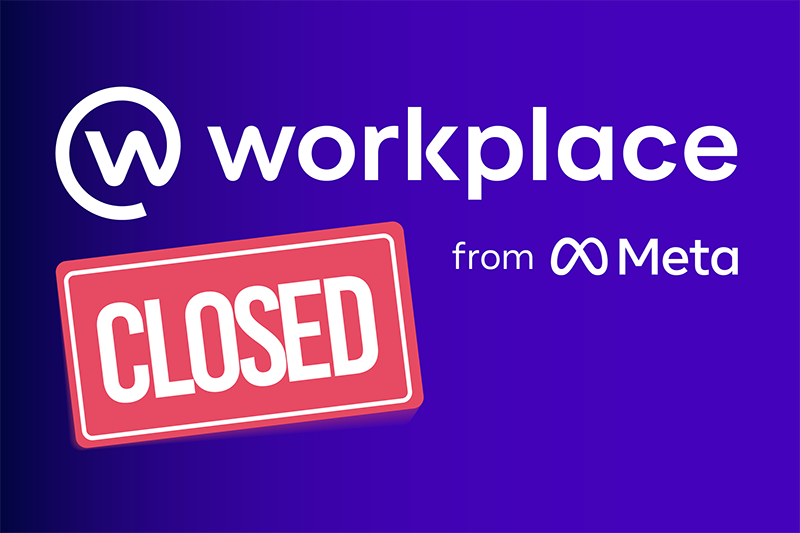
This announcement has raised concerns for many organizations: how to retrieve and preserve their data? How to support teams through this change, while ensuring business continuity?
The shutdown of Workplace is certainly disruptive, but it also presents a unique opportunity to rethink your digital workplace. For some time now, Workplace had stagnated—limited customization, weak integrations, and no long-term product vision. Now is the perfect time to review your usage, reassess your needs, and adopt a more modern, sustainable, and user-focused solution.
This article walks you through the key steps, best practices, and pitfalls to avoid for a successful migration from Workplace from Meta. Most importantly, it offers a positive perspective on this change—because a well-managed migration is a strategic opportunity to transform collaboration and communication in your organization.
Before jumping into the migration, start with a comprehensive assessment of how you currently use Workplace. This diagnostic will help define your needs, expectations, and priorities to ensure a smooth and efficient transition—without data loss.
Ask yourself the following questions to map out how Workplace is used:
The most effective way to perform this audit is to export your Workplace data for both quantitative and qualitative analysis.
Also gather feedback from users to better understand their expectations.
Migration is a collaborative project involving your entire organization:
Involving these stakeholders early on helps build a solution that fits your organization, removes barriers, and anticipates needs.
Not all data or features are equally important. Ask yourself:
This often-overlooked step is critical for success. A clear diagnostic serves as a compass for choosing the most relevant collaborative platform.
The shutdown of Workplace forces you to choose an alternative. But this is your chance to move beyond simple replacement and toward real improvement.
Ease of use, rich set of features, data security, interoperability, scalability, and cost—what matters most for your organization? You’re not looking for a clone of Workplace, but a platform that meets both your current and future needs.
Start by aligning your evaluation with your strategic priorities. Key criteria include:
Once you’ve shortlisted your options, set up a pilot group to try them out in real conditions and collect feedback.
Avoid going with the “closest replacement” to Workplace. This is your chance to:
Choosing a new platform in a rush is rarely a good idea. You need a solution that can grow with your organization:
Choose a platform that’s open, scalable, and future-proof.
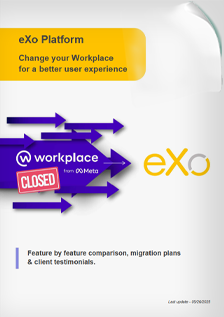
Workplace Migration Guide : Comparaisons, Plans and Testimonials
Discover, compare, and migrate to the best Workplace From Meta alternative



Discover, compare, and migrate to the best Workplace From Meta alternative
A successful migration is built on thorough planning and structure. Here are the key steps to ensure a seamless transition.
Use this opportunity to archive or delete outdated content, and organize the relevant data for your new platform.
Depending on volume and complexity, you can choose:
Most commonly transferred data includes:
Best practices to facilitate your migration:
Take advantage of the transition to rethink your workspace organization:
Some platforms offer:
These features can save time during migration.
For larger organizations, or those with multiple entities, a phased deployment is more effective:
To facilitate the project adoption, provide a launch kit with tutorials, FAQs, internal announcements, videos, etc.
Quality support is essential for success. A strong migration partner will help you:
Even with solid planning and a powerful tool, migration can go sideways. Here are common pitfalls to watch out for:
Workplace shuts down on August 31, 2025. Don’t let the pressure dictate rushed decisions. Plan early to compare, test, and mobilize teams properly.
Bulk-transferring all your historical data without cleanup can lead to:
Take time to filter, prioritize, and structure what really matters.
Data transfer is critical—but user adoption is everything. A successful migration is one that your people embrace.
Without proper onboarding and communication:
Don’t overlook UX and user champions—they’ll breathe life into the platform.
In a rush, you might opt for a fast-deploy, all-in-one tool that’s ultimately closed and limiting.
Risks include:
Go for open-source, flexible, and secure solutions that prioritize transparency and freedom.
Migration is a strategic moment. Don’t let it pass unnoticed—make it a teamwide transformation.
Use this time to:
Make the project inspiring and purposeful.
At first glance, Workplace’s shutdown might feel like a constraint. In reality, it could be the spark that ignites your organization’s digital transformation.
Rather than settling for a default replacement, use this as a chance to rethink your collaborative model.
Replacing Workplace is your chance to:
A sustainable solution helps you:
Migrating from Workplace also means creating a collaborative environment tailored to your culture. You can:
By taking time to assess your needs, choose the right platform, plan your migration, and support your users, you can turn this challenge into a strategic lever for improving collaboration, engagement, and internal performance.
With the right partner and the right platform, you have the opportunity to build a digital workplace that’s: more secure, more sustainable, more engaging.
Ready to take action and avoid last-minute stress?
Contact us to see how eXo Platform can support your migration and help you design the collaborative platform of the future.
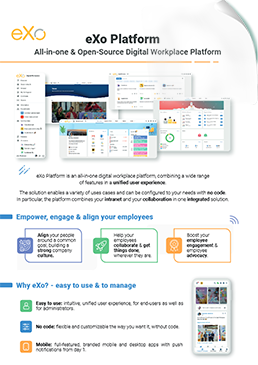
eXo Platform : The Open-Source
Digital Workplace Platform
Download the eXo Platform Datasheet and discover all the features and benefits
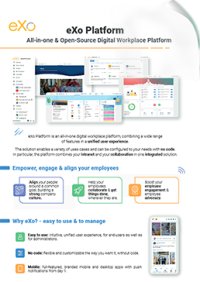

Download the eXo Platform Datasheet and discover all the features and benefits
( Your e-mail address will not be published)
I am the communication manager at eXo Platform. I found myself in communications a bit by chance, but this field brings together everything that pationates me: creativity, energy, meetings, collaborative work, sharing and exchanges of good practices. I need to give meaning to what I do and put people at the center of all my actions.